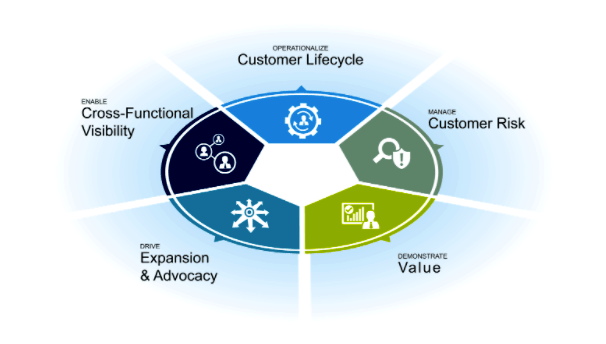Allison Pickens is VP of Customer Success & Business Operations at Gainsight.
Whenever I gather a few Chief Customer Officers together, our discussion quickly evolves into a group therapy session. Being CCO is a tough job. That’s because every great CCO knows that s/he has 2 sets of clients: external clients, and internal clients – i.e. his or her own team members.
If you believe in Servant Leadership, which I strongly do, you view your team members as clients. You’re in your role to serve them.
This post is about how to apply the same principles of Customer Success to support the success of your team members.
Challenges
Serving both sets of clients – while simultaneously controlling costs – can be challenging. That’s because:
- Your team feels your company’s challenges in a very personal way. When inevitably your product hasn’t yet caught up with customers’ needs, your CSMs, Support reps, and other Customer Success team members are on the front lines of fielding customers’ concerns. If they’re the type of folks who really want to help people (which hopefully they are!), these escalations will deeply affect them.
- Every quarter, you start at a 100% potential gross renewal rate. It can only go down from there. If not managed properly, this framework can result in everyone focusing on what’s going wrong, as opposed to your team’s victories. That’s not great for morale.
- You’re on the receiving end of new logos. You can’t control whether your sales team under- or over-performs plan, or whether their forecasts are accurate. That means you risk your team becoming overworked or being overstaffed. (Neither situation is good.)
- You have to achieve profitability goals, even as your product and market continue to evolve. Your CFO is holding you accountable for cost targets, but if your target customer is evolving, or your Product team launches a new release every 6 weeks (which is common among especially smaller companies), your team members have to invest time in their own training. Something has to give.
- Process change is necessary but tough. When your product or market is evolving, every department has to evolve with it, and that requires process change. But most people don’t like changing their habits, even when they know their situation will worsen if they don’t.
At Gainsight, we’ve built processes that have helped us meet our Customer Success goals – and many of those processes are documented in this blog. Later on, we realized that the same fundamental processes would allow us to achieve our Teammate Success goals. The analogy between Customer Success and Teammate Success best practices is wonderfully perfect.
The 5 Pillars of Customer Success (and Teammate Success)
We work with our customers on 5 areas of best practices, shown in the chart below.

Fascinatingly, each of these areas has a parallel in Teammate Success.

Think about how similar these pairs are:
- Need to focus on customer retention, not just acquisition ⇔ Need to focus on team member retention, not just recruiting top performers
- Hand-off from Sales to Customer Success ⇔ Hand-off from Recruiting to HR
- Consistent journey of milestones for customers ⇔ Consistent journey of milestones for team members
- Proactively detecting early warning signs of customer churn ⇔ Proactively detecting signs that a team member is not thriving
- Helping a customer see how much value they’re getting from the product ⇔ Helping a team member feel proud of their accomplishments
- Making customers so successful that they advocate on behalf of your product ⇔ Making team members so successful that they refer friends to apply for jobs at your company
- Aligning departments around the success of your customers ⇔ Aligning departments around the success of your team members
Using our Customer Success processes as a benchmark, we brainstormed the following processes to achieve Teammate Success. We haven’t implemented all of these yet, but the framework has become our North Star. We’re even considering putting these processes into our own instance of Gainsight.
Teammate Journey
The Teammate Journey processes are straightforward. I’ll highlight the monthly NPS survey as a way to get frequent data on how the team is doing. I’ll also highlight the Success Plan: just as we must understand our customers’ goals in using our product, we must understand what our teammates are looking to get out of their experience at Gainsight, as well as share what contributions the company needs from them. Then we have to chart a path to achieve those outcomes.

Managing Risk
In this section, I refer to the concept of the Alliance in Reid Hoffman’s book. Quoting the Amazon summary: “As a manager you want your employees to help transform the company for the future. And your employees want the company to help transform their careers for the long term.”
In managing risk in a company’s relationship with a team member, we must understand the risk from the perspective of each of the team member and the company.

Just as with customer risk, it’s imperative to drive to the root cause of the risk. For example: Is the team member not succeeding because they need to develop certain skills, or because their strengths aren’t matched to the demands of their current role? Identifying the root cause helps us identify the right solution – whether it’s more training (in the first case), or switching roles (in the second case).
Demonstrate Value

Career Growth & Advocacy

Cross-Functional Collaboration


